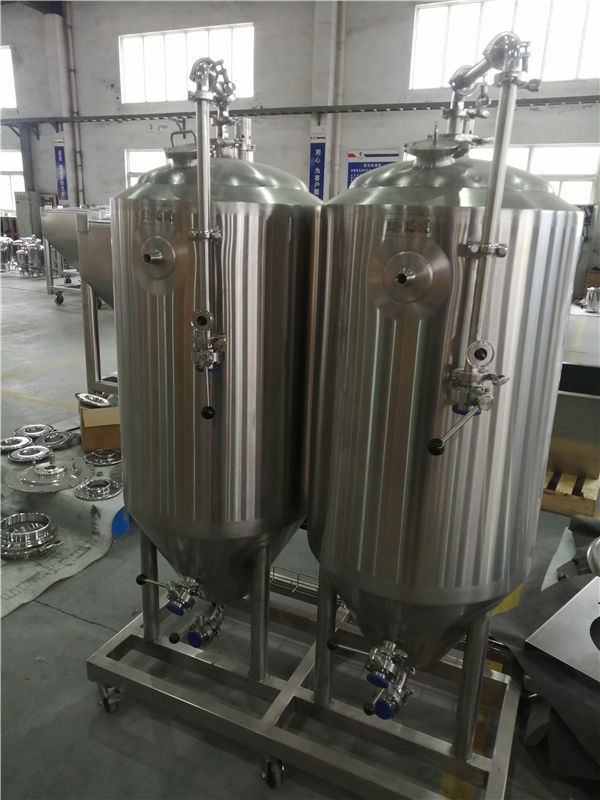Fermentation tank refers to the device used for microbial fermentation in industry. Its main body is generally a main cylinder made of stainless steel plate, with a volume of 1m³ to hundreds of m³. In design and processing, attention should be paid to the tight and reasonable structure.
It can withstand steam sterilization, has a certain degree of operational flexibility, minimizes internal accessories (avoids dead corners), has strong material and energy transfer performance, and can be adjusted to facilitate cleaning and reduce pollution. It is suitable for the production of a variety of products and reduces energy consumption.
Uses
The structure of the fermentation tank used for anaerobic fermentation (such as the production of alcohol and solvents) can be relatively simple. The fermentation tank used for aerobic fermentation (such as the production of antibiotics, amino acids, organic acids, vitamins, etc.) needs to continuously introduce a large amount of sterile air into the tank, and in order to consider the utilization rate of the introduced air, the fermentation tank structure is relatively complex. Commonly used ones are mechanical stirring fermentation tanks, bubbling fermentation tanks and airlift fermentation tanks.
The fermentation process of dairy products and wine is a sterile and pollution-free process. The fermentation tank adopts an aseptic system to avoid and prevent the contamination of microorganisms in the air, greatly extending the shelf life and purity of the product. The tank body is specially designed and installed with sterile breathing pores or sterile positive pressure fermentation systems. The tank body is equipped with a Milo plate or a labyrinth jacket, which can be passed through a heating or cooling medium for circulating heating or cooling. The capacity of the fermentation tank ranges from 300-15000L in various specifications. Fermentation tanks can be divided into laboratory small fermentation tanks, pilot production fermentation tanks, large fermentation tanks, etc. according to the scope of use.
Fermentation tanks are widely used in dairy products, beverages, bioengineering, pharmaceuticals, fine chemicals and other industries. The tank body is equipped with inter-layers, insulation layers, and
can be heated, cooled and insulated. The tank body and the upper and lower filling heads (or cones) are all processed with spinning R angles. The inner wall of the tank is mirror polished, with no sanitary dead corners, and the fully enclosed design ensures that the material is always mixed and fermented in a pollution-free state. The equipment is equipped with air breathing holes, CIP cleaning nozzles, manholes and other devices.
Classification of fermentation tanks: According to the equipment of the fermentation tank, it is divided into mechanical stirring ventilation fermentation tanks and non-mechanical stirring ventilation fermentation tanks;
According to the growth and metabolism needs of microorganisms, it is divided into aerobic fermentation tanks and anaerobic fermentation tanks.
The fermentation tank is a kind of equipment for mechanical stirring and fermentation of materials. The equipment adopts an internal circulation method, using a stirring paddle to disperse and break bubbles. It has a high dissolved oxygen rate and good mixing effect. The tank body is made of imported SUS304 or 316L stainless steel, and the tank is equipped with an automatic spray cleaning head to ensure that the production process meets GMP requirements.

Structural characteristics
1. Online CIP cleaning and SIP sterilization (121°C/0.1MPa) are possible.
2. Designed according to sanitary requirements, the structural design is very user-friendly and easy to operate. The transmission is stable and the noise is low.
3. Suitable diameter-to-height ratio design, customized stirring device on demand, energy saving, good stirring and fermentation effects.
4. The inner tank surface is mirror polished (roughness Ra≤0.4μm); the inlet and outlet pipes, sight glasses, manholes and other process openings and the inner tank welding points are all made of arc transition by stretching and flanging process, which is smooth, easy to clean and has no dead corners, ensuring the reliability and stability of the production process and meeting the requirements of "cGMP" and other specifications.
Main components
Tank: Mainly used to cultivate and ferment various bacteria, with good sealing (to prevent bacteria from being contaminated)
There is a stirring paddle in the tank for continuous stirring during the fermentation process
The bottom ventilated Sparger is used to introduce air or oxygen required for bacterial growth
There are control sensors on the top plate of the tank, the most commonly used are pH electrodes and DO electrodes, which are used to monitor the changes in pH and DO of the fermentation liquid during the fermentation process. The controller is used to display and control the fermentation conditions, etc.
Fermentation process
Pretreatment: raw material crushing, gelatinization, saccharification (such as rice and sorghum need to be crushed to promote starch release).
Sterilization: Steam sterilization (121℃, 30 minutes), tank pressure must be controlled (0.12-0.15MPa) and condensed water must be avoided.
Inoculation and fermentation: Inoculate bacteria (such as yeast) in proportion, and control temperature, pH value, and dissolved oxygen (DO) in stages.
Post-processing: distillation (white wine), clarification (fruit wine), aging (yellow wine).
Technical parameter
Model | Volume | Tank | |
Diameter | Height | ||
JP-200 | 200L | φ600 | 700mm |
JP-300 | 300L | φ700 | 700mm |
JP-400 | 400L | φ800 | 700mm |
JP-500 | 500L | φ900 | 700mm |
JP-1000 | 1000L | φ1000 | 1000mm |
JP-2000 | 2000L | φ1300 | 1220mm |
JP-3000 | 3000L | φ1200 | 1500mm |
JP-4000 | 4000L | φ1600 | 1800mm |
JP-5000 | 5000L | φ1700 | 2000mm |
Plate Centrifuges Application
Esterification Reaction In Fragrance Synthesis
Fractionating Geranium Essential Oil
Contact: Project Manager
Phone: +86-18120438367
Tel: +86-18120438367
Email: info@tycoretech.com
Add: No. 1, Optics Valley Avenue, East Lake New Technology Development Zone, Wuhan, Hubei, China
We chat
